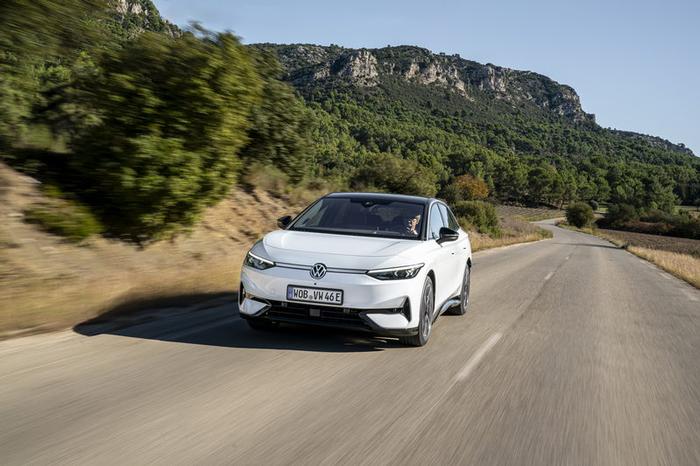2024 Volkswagen ID.7 Fastback Review

We've driven the new VW ID.7 EV.
The Volkswagen ID.7 is the brand’s flagship electric saloon with a big range.
Review
Pros: efficient powertrain, generous interior space, overall refinement
Cons: bland styling, haptic steering wheel controls
Volkswagen ID.7 Design
The arrival of the Volkswagen ID.7 comes at a time when an increasing number of brands are adding car models to their ranges. Tesla has already had the lead here, but the Hyundai Ioniq 6, Polestar 2 and BMW i4 all serve as worthy alternatives to electric SUVs.
The ID.7’s exterior appearance has primarily been shaped by a quest to make the car as aerodynamic as possible. Having a car that has a slippery shape can bring big benefits for reducing energy consumption and prolonging driving range. Meanwhile, the sleek headlights feature Volkswagen’s latest LED technology and, similar to other models in the range, there is an illuminated light bar stretching across the front.
Elsewhere, the door handles sit flush to clean up the airflow and the look, while the contrasting roof includes a silver metallic section similar to that found on the ID.4 and ID.5. Around the rear of the ID.7 are detailed LED lights that wrap around the whole width of the car.
The long roofline of the ID.7 benefits rear passenger headroom, helps the aerodynamics and allows for a hatchback opening. There are 532 litres of space, and the large aperture makes it easy to load bulkier items.
Volkswagen ID.7 Interior
Sit into the Volkswagen ID.7, and the first thing you’ll notice is the 15-inch touchscreen that occupies the entire centre console. It contains almost every control aspect of the car’s systems, and has an angled capacitive touch bar along its base for adjusting audio volume and cabin temperature. In previous ID. models, this bar was criticised for not being backlit, which Volkswagen has remedied this time. There are some improvements to how the native infotainment system functions, and there are Android and Apple connectivity options, too.
Volkswagen has stuck with haptic controls on the multifunction steering wheel, behind which is a small digital instrument display. The reason for a smaller display is that it equips the ID.7 with an extensive augmented reality head-up display as standard. This shows all the relevant info in your line of sight and cleverly overlays directional arrows for navigation that appear as if they’re floating in front of the car as you drive along.
Material quality inside is to the usual high Volkswagen standard, and the entire design is clean and uncluttered — primarily as so much of the car’s functionality is within the touchscreen. One of the positives of the ID.7’s overall length is that rear passenger space is quite generous, with plenty of legroom and headroom.
Volkswagen ID.7 Performance & Drive
A single powertrain will be available in the Volkswagen ID.7 from launch, made up of a 77kWh battery and a 210kW (286hp) electric motor that drives the rear wheels. That motor is different from what already powers other Volkswagen ID. models, with more performance and better efficiency. The latter becomes apparent as you begin driving, with the trip computer displaying reasonable energy consumption figures. Whether most people will be able to achieve the official WLTP range of 621 kilometres is debatable, but the ID.7 is undoubtedly a car that can easily cover long distances. When you need to stop and charge, the car can draw down power at up to 175kW, adding 204 kilometres of range in ten minutes in theory.
While the ID.7 has ample performance thanks to its new electric motor, it isn’t a car that feels all that sporty. Instead, this Volkswagen is more about comfort and refinement, something it has in spades. However, when pressed, it will accelerate from 0-100km/h in 6.5 seconds and has a top speed limited to 180km/h.
Being electric is already a good start when trying to make a car feel refined, and to that, Volkswagen engineers have added plenty of sound insulation, including acoustically optimised glass. The car’s shape and low aerodynamic drag also help to reduce wind noise at higher speeds.
During motorway driving and at speeds above 90km/h, the ID.7’s automatic lane change function allows the car to safely switch lanes with a single indicator tap. The car will check its surroundings to ensure it’s safe to move and then perform the manoeuvre in a very natural way.
Our first drive in the ID.7 also allowed us to test the car’s adaptive suspension setup that can adjust each wheel in real-time to best cope with the surface underneath. Drivers can switch between different driving modes, which also affects the setup. In the Sport setting, there’s a surefooted feeling when driving quicker.
Volkswagen ID.7 Pricing
At the time of writing, the pricing and specification details for the Volkswagen ID.7 are still in the final stages of being confirmed. There will be just one battery and powertrain available at launch, though this will expand over time to include higher performance outputs and an estate body style in 2024.
Carzone Verdict
The ID.7 is a welcome addition to the Volkswagen range, offering a great driving range and a refined driving experience in a very polished package. It looks less divisive than the Hyundai Ioniq 6 and is as sophisticated as several more expensive premium electric cars. A broad appeal will put this car on the radars of company car drivers, taxis and families that perhaps want something other than an SUV.



